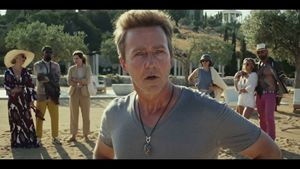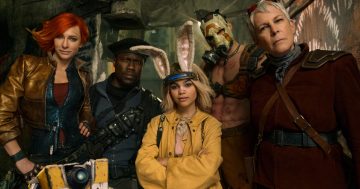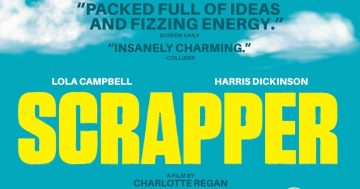For decades movie bad guys were easily identified by their moustaches or mwah-ha-has. Amelia Tait* says that these days, evil wears a hoodie.
 Not too long ago, movie villains were easily identified by their facial scarring, malevolent laughs, and weirdly high collars—but in recent years, the shorthand has shifted significantly.
Not too long ago, movie villains were easily identified by their facial scarring, malevolent laughs, and weirdly high collars—but in recent years, the shorthand has shifted significantly.
Turtlenecks and hoodies are the hallmarks of today’s sinister supervillains, as the billionaire tech bro has increasingly become the antagonist of choice.
Take Rian Johnson’s Oscar-nominated Glass Onion: A Knives Out Mystery, which centers around the murderous gray T-shirted CEO, Miles Bron (Edward Norton).
Bron is set to launch an alternative (and dangerous) hydrogen-based fuel before he is not-so-gradually revealed to be an idiot.
Audiences have compared him to billionaire boy of the moment, Elon Musk.
But that’s the obvious one.
The more nefarious of these supervillains hide in plain sight.
Take The Santa Clauses, the serialized sequel to The Santa Clause film series that debuted in 1994.
Premiering on Disney+ last November, the show starts with Santa (Tim Allen) retiring and looking for a replacement.
He chooses tech developer and Jeff Bezos-wannabe Simon Choksi (Kal Penn).
Surprise, surprise, drone-based deliveries are ultimately not the meaning of Christmas, and the be-hoodied Simon turns out to be the bad kind of disruptive before his daughter puts him right.
A decade after Facebook origin story The Social Network debuted in 2010, rich tech CEOs have increasingly recurred as bad guys—or at least antiheroes.
In 2018, Upgrade featured AI-chip inventor Eron Keen (yes, really).
In 2021, Don’t Look Up had the turtlenecked phone developer Peter Isherwell and Free Guy had egotistical gaming CEO Antwan Hovachelik.
The trend has even trickled down into children’s entertainment: Before The Santa Clauses, 2021 animated film Ron’s Gone Wrong featured tech executive Andrew Morris, a villain intent on “data-harvesting” (he actually says those words on screen).
The mad scientist has evolved into the mad disruptor, but why is this happening, and why now?
To some degree, movie villains have always reflected societal anxieties—the mad scientist trope first emerged, says University of Warwick film fellow James Taylor, because of fears around the atomic bomb.
But Taylor also notes that villains don’t just reflect our fears, “they also feed into these anxieties, helping to shape and spread them.”
Superman antagonist Lex Luthor is the perfect example of this evolving villainy.
“The character was initially a mad scientist, then in the 1980s became a CEO, and in the recent screen incarnation Jesse Eisenberg brought in qualities of the tech bro,” Taylor says.
“We can easily relate this to changing cultural concerns.” After all, we no longer associate scientists with “new technologies for annihilating humanity.”
Instead, “in the current climate crisis, scientists are frequently presented as noble figures struggling in vain to make callous CEOs and politicians recognize and reverse harm being done to the planet.”
Meanwhile, you only have to open a newspaper to see tech honchos gone bad.
Elon Musk’s cars are crashing, former Theranos CEO Elizabeth Holmes faces 11 years in prison for defrauding investors, while WeWork founder Adam Neumann stands accused of pregnancy discrimination.
No wonder these realities are increasingly represented in fiction.
Ron’s Gone Wrong writers Sarah Smith and Peter Baynham admit it was concerns about their own children’s tech use that inspired the film.
The computer-animated comedy is about B-bots, robot companions for children that help them make friends via algorithm.
When one B-bot, Ron, malfunctions, Bubble CEO Marc Wydell is intrigued, while executive Andrew Morris wants to destroy Ron and use the other bots to spy on kids for profit.
“We sort of saw them as the two faces of Mark Zuckerberg,” explains Smith, “We saw it as the idealist who says, ‘I want to connect the world, I want to create something amazing that will bring something together’ and the other part, which is …”
Baynham helpfully finishes her sentence: “‘I want to rule the world!’”
Before writing the film, Smith and Baynham were alarmed by children’s naivety around Big Tech agendas.
“My daughter used to say to me, ‘Mom, we need to buy that washing powder because it makes everything smell so fresh!’” Smith says.
“One of the reasons for making the film is because we’re not really talking to kids about this.
“Screen time is the thing that’s most fraught in every single household every single day, and yet we don’t really have ways of sitting down and having a conversation about what it is we’re scared of, what the dangers are.”
Baynham says they included both a good guy and a bad guy tech exec precisely because many tech bros don’t see themselves as villains.
“They think they’re on a heroic mission to make the world a better place,” he says.
“They’re not an evil person, they’ve got blinkers on.”
Visually, good guy Marc is more of a Zuckerberg figure (hoodie), while baddie Andrew resembles Steve Jobs (turtleneck).
Billionaire bros and their chosen uniforms are extremely easy to parody on screen, which may also explain the rise of the tech villain.
“We leaned into the tropes, we leaned into the Steve Jobs outfit,” Smith says, “What you’re trying to do is sum up in a few broad, simple strokes the kind of motivations and people that are working inside that industry.”
As long as tech bros continue to tech bro, they’re likely to keep popping up on film.
Ultimately, these villains are an easy way to personify anxieties around emerging technologies—humans are humans; wires and chips aren’t (yet).
Smith notes that technology has “extraordinary power” to change the world but argues that the ideology behind the tech often also has the power to harm.
“Kids’ films ought to actually deal with what’s going on in their lives, and this is the biggest thing that’s changed in the raising of children that any of us can remember,” she says.
“It’s really super important to find cultural ways to provoke the conversation.”
Even if they have to do it on another screen.
Amelia Tait is a freelance journalist who writes on culture, trends, and the internet for publications such as The Guardian, The New York Times, Vice, and GQ.
This article first appeared at wired.co.uk











